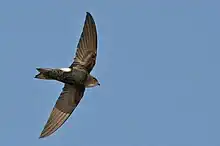| Horus swift | |
|---|---|
 | |
| Horus swift in South Luangwa National Park, Zambia | |
| Scientific classification | |
| Domain: | Eukaryota |
| Kingdom: | Animalia |
| Phylum: | Chordata |
| Class: | Aves |
| Clade: | Strisores |
| Order: | Apodiformes |
| Family: | Apodidae |
| Genus: | Apus |
| Species: | A. horus |
| Binomial name | |
| Apus horus (Heuglin, 1869) | |
The Horus swift (Apus horus) is a small bird in the swift family Apodidae that is found in sub-Saharan Africa. Horus, whose name this bird commemorates, was the ancient Egyptian god of the sun, son of Osiris and Isis.
Taxonomy
The Horus swift was formally described in 1869 by the German explorer and ornithologist Theodor von Heuglin under the binomial name Cypselus horus.[2][3] The specific epithet is from Ancient Egyptian mythology: Horus was the god of the sun.[4] This species is now one of 20 swifts placed in the genus Apus that was introduced in 1777 by the Italian naturalist Giovanni Antonio Scopoli.[5] The species is treated as monotypic. The subspecies A. h. fuscobrunneus and A. h. toulsoni were formerly recognised but are now considered to be colour morphs of the nominate form.[5][6]
Description
The Horus swift is 13–15 cm (5.1–5.9 in) long and quite bulky. It appears entirely blackish except for a white patch on the chin and a white rump. It has a medium length forked tail. It has a fluttering flight like little swift. The little swift has a square tail, and more extensive white on the rump than Horus, and white-rumped swift has a more deeply forked tail and a narrower white band. The call is a buzzing peeeeooo, peeeeooo.
Distribution and habitat
The swift breeds in sub-Saharan Africa. It has an extensive continuous distribution from eastern and southern South Africa north to southern Zambia and central Mozambique, and has recently colonised the De Hoop Nature Reserve area of the Western Cape. It also occurs very discontinuously in much of the rest of the sub-Saharan region, with the Ethiopian mountains and the area from central Kenya into Uganda having large populations. Identification difficulties confuse the limits of this species' range. Birds in South Africa are migratory, wintering further north. Other populations are resident apart from local movements.

Behaviour
The Horus swift breeds in old burrows of bee-eaters, ground woodpeckers, kingfishers and martins, which are typically in natural or artificial sandy banks. The flat nest of vegetation and hair, glued with saliva is built at the end of the tunnel and 1-4 eggs are laid. The eggs are incubated for 28 days to hatching, and the fledging period is about 6 weeks. This species is not colonial, but the nature of its breeding habitat means that a number of pairs may be scattered through a bee-eater or banded martin colony. It feeds at middle levels over adjacent habitats, but avoids large towns.
References
- ↑ BirdLife International (2016). "Apus horus". IUCN Red List of Threatened Species. 2016: e.T22724997A94883170. doi:10.2305/IUCN.UK.2016-3.RLTS.T22724997A94883170.en. Retrieved 11 November 2021.
- ↑ von Heuglin, Theodor (1869). Ornithologie Nordost-Afrika's : der Nilquellen- und Küsten Gebiete des Rothen Meeres und des nördlichen Somal-Landes (in German). Vol. 1. Cassel [Kassel], Germany: T. Fischer. p. 147.
- ↑ Peters, James Lee, ed. (1940). Check-list of Birds of the World. Vol. 4. Cambridge, Massachusetts: Harvard University Press. p. 230.
- ↑ Jobling, James A. (2010). The Helm Dictionary of Scientific Bird Names. London: Christopher Helm. p. 195. ISBN 978-1-4081-2501-4.
- 1 2 Gill, Frank; Donsker, David; Rasmussen, Pamela, eds. (December 2023). "Owlet-nightjars, treeswifts & swifts". IOC World Bird List Version 14.1. International Ornithologists' Union. Retrieved 12 January 2024.
- ↑ Jansen, Justin; Driessens, Gerald (2023). "Horus Swift: identification, plumage variation and distribution". Dutch Birding. 45 (2): 73–116.
External links
- Horus swift - Species text in The Atlas of Southern African Birds.
